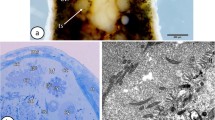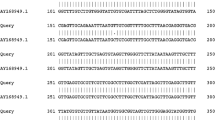Summary
Testis follicles of Lepidoptera contain a large somatic cell termed Verson's cell. The present study focuses on the structure of Verson's cells and neighbouring germ cells in the Mediterranean mealmoth, Ephestia kuehniella (Pyralidae), using electron microscopy, antitubulin immunofluorescence, and phalloidin incubation for the visualization of microfilaments. Verson's cells of young larvae are connected with the follicle boundary and show large areas containing packages of glycogen particles, whereas Verson's cells of pupae lie freely within the testis follicle and are largely devoid of glycogen. Both developmental stages of Verson's cells have in common the presence of a dense cytoplasmic network of microtubules. A juxtanuclear subset of the cytoplasmic microtubule array is recognized by an antibody against acetylated microtubules. This indicates that more stable microtubules exist in this region. Microfilaments are arranged parallel to the cytoplasmic microtubules. The microtubule-microfilament-complex forms a cytoskeleton that may keep larger organelles, such as mitochondria and lysosomes, in a juxtanuclear position. Chromatin within the nuclei of Verson's cells is largely decondensed and nuclear pores are abundant. This indicates a high synthetic activity within the cells. The development of cells directly attached to Verson's cells, viz. prespermatogonia, may be controlled by the Verson's cells. Prespermatogonia, which differ in cytoplasmic density from spermatogonia further away from Verson's cells, may represent stem cells that give rise to spermatogonia and somatic cyst cells upon detachment from Verson's cells. This suggestion is compatible with the low division rate of prespermatogonia.
Similar content being viewed by others
References
Ashkin A, Schütze K, Dziedzic JM, Euteneuer U, Schliwa M (1990) Force generation of organelle transport measured in vivo by an infrared laser trap. Nature 348:346–348
Buder JE (1915) Die Spermatogenese von Deilephila euphorbiae L. Arch Zellforsch 14:26–78
Carson HL (1945) A comparative study of the apical cell of the insect testis. J Morphol 77:141–155
Giebultowicz JM, Loeb MJ, Borkovec AB (1987) In vitro spermatogenesis in Lepidopteran larvae: role of the testis sheath. Invertebr Reprod Dev 11:211–226
Goldschmidt R (1931) Neue Untersuchungen über die Umwandlung der Gonaden bei intersexuellen Lymantria dispar R. Wilhelm Roux' Arch 124:618–653
Grünberg K (1903) Untersuchungen über die Keim- und Nährzellen in den Hoden und Ovarien der Lepidopteren. Z Wiss Zool 74:327–395
Johnson GD, Nogueira Araujo CGM de (1981) A simple method of reducing the fading of immunofluorescence during microscopy. J Immunol Methods 43:349–350
Kirschner M, Mitchinson TJ (1986) Beyond self-assembly: from microtubules to morphogenesis. Cell 45:329–342
Leclercq-Smekens M (1978) Reproduction d'Euproctis chrysorrhea L. (Lépidoptère Lymantriidae). II. Aspects cytologiques et rôle de la cellule apicale (cellule de Verson) des testicules. Acad R Belg Bull Class Sci, ser 5, 64:318–332
MacRae TH, Langdon CM (1989) Tubulin synthesis, structure, and function: what are the relationships? Biochem Cell Biol 67:770–790
Mazia D (1984) Centrosomes and mitotic poles. Exp Cell Res 153:1–15
McDonald K (1989) Mitotic spindle ultrastructure and design. In: Hyams JS, Brinkley BR (eds) Mitosis. Academic Press, London, pp 1–38
Menon M (1969) Structure of the apical cells of the testis of the Tenebrionid beetles: Tenebrio molitor and Zophobas rugipes. J Morphol 127:409–430
Muckenthaler FA (1964) Autoradiographic study of nucleic acid synthesis during spermatogenesis in the grasshopper, Melanoplus differentialis. Exp Cell Res 35:531–547
Nicklas RB (1975) Chromosome movement: current models and experiments on living cells. In: Inoué S, Stephens RE (ed) Molecules and cell movement. Raven Press, New York, pp 97–117
Paweletz N (1967) Zur Funktion des “Flemming-Körpers” bei der Teilung tierischer Zellen. Naturwissenschaften 54:533–535
Pickett-Heaps JD (1969) The evolution of the spindle apparatus: an attempt at comparative ultrastructural cytology in dividing plant cells. Cytobios 1:257–280
Piperno G, Fuller MT (1985) Monoclonal antibodies specific for an acetylated form of α-tubulin recognize the antigen in cilia and flagella from a variety of organisms. J Cell Biol 101:2085–2094
Rappaport R (1986) Establishment of the mechanism of cytokinesis in animal cells. Int Rev Cytol 105:245–281
Ritzén EM, Hansson V, French ES (1989) The Sertoli cell. In: Burger H, Kretser D de (eds) The Testis. Raven Press, New York, pp 269–302
Roosen-Runge EC (1977) The process of spermatogenesis in animals. Cambridge Univ Press, Cambridge
Schliwa M, Blerkom J van (1981) Structural interaction of cytoskeletal components. J Cell Biol 90:222–235
Schulze E, Kirschner M (1988) New features of microtubule behaviour observed in vivo. Nature 334:356–359
Spichardt C (1886) Beitrag zu der Entwicklung der männlichen Genitalien und ihrer Ausführgänge bei Lepidopteren. Verh Naturh Ver Preuss Reinl 43:1–34 cited in: Carson HL (1945) A comparative study of the apical cell of the insect testis. J Morphol 77:141–155
Szöllösi A, Marcaillou C (1979) The apical cell of the locust testis: an ultrastructural study. J Ultrastruct Res 69:331–342
Traut W, Weith A, Traut G (1986) Structural mutants of the W chromosome in Ephestia (Insecta, Lepidoptera). Genetica 70:69–79
Tucker JB (1984) Spatial distribution of microtubule-organizing centers and microtubules. J Cell Biol 99:55s-62s
Unger E, Böhm KJ, Vater W (1990) Structural diversity and dynamics of microtubules and polymorphic assemblies. Electron Microsc Rev 3:355–395
Vallee RB, Shptner HS, Paschal BM (1989) The role of dynein in retrograde axonal transport. Trends Neurosci 12:66–70
Verson E (1889) Zur Spermatogenesis. Zool. Anzeiger 12:100–103
Webster DR, Borisy GG (1989) Microtubules are acetylated in domains that turn over slowly. J Cell Sci 92:57–65
Wolf KW (1987) Cytology of Lepidoptera. I. The nuclear area in secondary oocytes of Ephestia kuehniella. Z. contains remnants of the first division. Eur J Cell Biol 43:223–229
Wolf KW, Bastmeyer M (1991) Cytology of Lepidoptera. V. The microtubule cytoskeleton in eupyrene spermatocytes of Ephestia kuehniella (Pyralidae), Inachis io (Nymphalidae), and Orgyia antiqua (Lymantriidae). Eur J Cell Biol 55:225–237
Wulf E, Deboben A, Bautz FA, Faulstich H, Wieland T (1979) Fluorescent phallotoxin, a tool for the visualization of cellular actin. Proc Natl Acad Sci USA 76:4498–4502
Zick K (1911) Beiträge zur Kenntnis der postembryonalen Entwicklungsgeschichte der Genitalorgane bei Lepidopteren. Z Wiss Zool 98:430–477
Author information
Authors and Affiliations
Rights and permissions
About this article
Cite this article
Wolf, K.W. The structure of Verson's cells in Ephestia kuehniella Z. (Pyralidae, Lepidoptera). Cell Tissue Res 266, 525–534 (1991). https://doi.org/10.1007/BF00318594
Accepted:
Issue Date:
DOI: https://doi.org/10.1007/BF00318594




